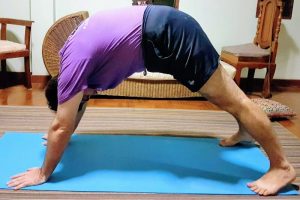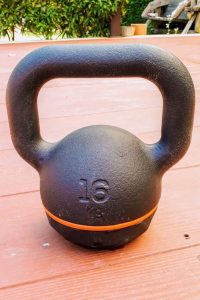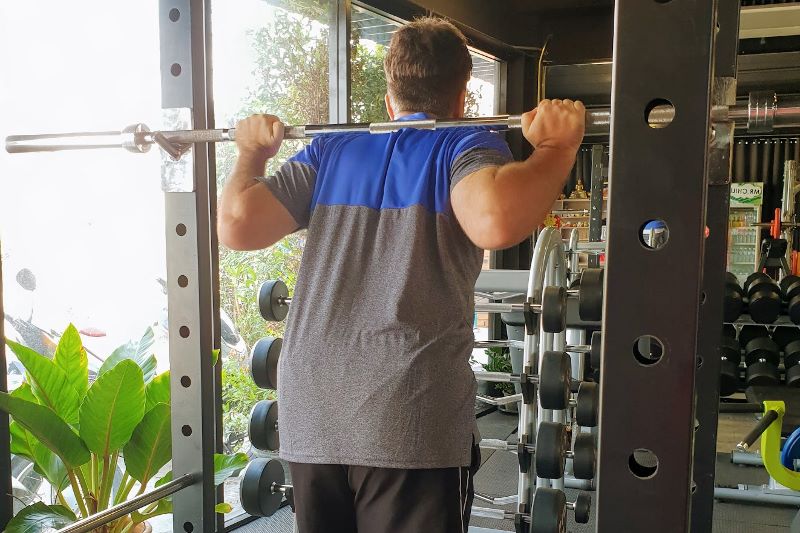First Gym Visit: How to Start Strength Training
I pulled out my new training log book and wrote: “Today I walked into a gym for the first time in my life.” I was never interested in going to a gym, then one day I was. I was seriously out of shape, in my mid forties, and completely lacking in knowledge. I had some hard work ahead of me.
The best way to get started with strength training is to just do it. Of course, everyone worries about looking silly, potential injuries and what program they should follow. The immense health and personal development benefits far outweigh any of these concerns. I want to share my own story of my first gym visit, and the results of sticking with a training program.
You may look at the picture above and think I don’t look as bad as I am claiming. This is the story of how I got out of shape, and the 5 months work it took before I walked into the gym that day.
As a teenager, I heard someone in authority say that lifting weights was all about vanity. Having no reason to doubt this, I accepted the supposed wisdom at face value. I think at the time (late 80’s or early 90’s) I may have formed the same opinion if I had visited a gym for myself.
In any case, I grew up and became an Engineer with an office job. Exercise never really came up again as a point of interest until many years later.
My First Gym Visit Should Have Come Sooner: 20 Years of Lower Back Pain
After a few years as a sedentary office worker and enthusiastic eater, I put on some weight and hurt my back.
I did not have continuous pain for 20 years, but it never completely went away. Sometimes it would flare up and I would need to take a couple of days off work. In one memorable incident, I left my own wedding reception in an ambulance. Mostly it just made me grumpy and more sedentary.
I had a couple of good years relief with my back, and was playing a lot of golf. At some level, I am sure I understood the exercise was good for me. I let this opportunity for improved health slip by and stopped playing after a while.
It all came to a head when I stopped working in Australia and moved to live in Thailand. I went straight from two decades of office work to establishing a garden in hard compacted clay. I snapped a few wooden hoe handles in the clay, and bent a few steel-handled implements. I felt like something similar was happening in my body at times.
I was also quite obese, so any time I flew on a plane or slept on my side (most nights) I experienced discomfort afterwards.
By 2015 I was spending a lot of my time in bed. I was not in agony, but it was difficult to get up in the morning, difficult to sit or to stand. Each day I found that going and lying down for lengthy periods of time made things easier.
I knew this was an unproductive way to live. I mistakenly believed that this would assist whatever healing process needed to occur in my body.
A Pain Breakthrough: Walking It Off

I was desperate to get better as my wife and I were planning a 1 month vacation in Europe at the end of the year. So, doing what I thought was best, I stayed in bed. The result was that I did not get much better, I went to Europe and just tried to walk around with the pain.
Then something amazing happened. We did a lot of walking around Frankfurt and Prague. By the time we got to Vienna at the end of the first week I was largely pain free and had no trouble bouncing out of bed in the morning. I did not have time to think about it, I just went out and enjoyed more walking.
Later when we returned home, it struck me that the answer should have been obvious for years. I felt a bit silly, and knew if I dwelled on it too much I might experience some regret. I was feeling really good so I just accepted things and moved on.
Energized by a Plant-Based Diet: I Decided to Exercise
Not much change for the next 2 and a half years. I was largely pain free and more active, but still limited by tiredness and general sluggishness due to my weight. Then I started eating a plant-based diet. I have written a separate post about how I unexpectedly became vegan.
I started to experience some major changes in my mind and body as a result of overhauling my diet. By the two month mark, I had lost 8 kg / 18 lbs and started to feel like I had extra energy to burn. I always knew that I would need to “get in shape” some day, but had assumed that this meant running. That was the sticking point.
I have at times in the past done some running, but it takes an inconvenient amount of time, you get hot and sweaty, and it is easy to find excuses to stop. Once you stop it is hard to start again. I have relatively short legs and a naturally heavy body structure, running was never going to be fun.

I was not ready to start running again after a 20 year break. Instead I tried to go for some walks at an aggressively brisk pace. This was easier than running but has many of the same problems, and takes even longer.
I knew that exercise was not contributing much directly to my weight loss. Also, it would be much easier to exercise at a lower weight. With a convenient excuse, it was easy for my to stop after about 4 or 5 walks.
Part of the reason why I attempted to walk rather than run was concern about injury. How would my body cope with the stress after so many years of inactivity?
In addition, my body was changing shape and composition at this time. I first developed back pain when I lost a lot of weight in my mid 20’s. I harbored a strong suspicion that sudden weight loss had brought this on. I now know this was not really a valid concern, but it was a good motivator to start exercising.
I wanted to increase my flexibility and mobility as insurance against possible injury as I lost weight. This led my to spend some time on YouTube, getting a lot of unscientific advice about “myofascial release”, “muscle activation” and so forth. None of this did any real harm, but importantly I strayed onto some good content about strength training.
Perhaps I didn’t need to run? Could the debilitation I had suffered with back pain all be due to a lack of strength? Maybe exercising with free weights is not just about vanity. I learned that strength training is a distinct activity from bodybuilding.
I Needed to Visit a Gym, But Did Not Feel Ready
I was watching something on YouTube about stretching hip flexors to address back pain when the trainer said “Of course, we all know that squatting is the king of all exercises”. Do we know that? I was vaguely aware of what a squat was, I must have seen a squat attempted on TV at some point. Walking into the kitchen, I tried to squat and, as expected, I needed to lean against the fridge to avoid falling down.
I figured that I should persist and within a month or so I was doing 5 sets of 20 “air squats” every 2nd day with ever-diminishing muscle soreness on the days between.
Somewhere in that month I went and got some dumbbells and started doing some overhead presses (I had already picked up that bicep curls were mostly for teenage boys, or teenage boys in adult bodies). Light weights, but I got up to a hundred reps of dumbbell presses every 2nd day.

I needed something more challenging as I didn’t want to just work up to doing thousands of easy reps. I went out and bought a moderately heavy (for me) kettlebell. Not ready to attempt kettlebell swings just yet, I just continued squatting, now with a 16 kg (35 lb) kettlebell tucked under my chin.
I worked on my squats for a few weeks, working through a bit more soreness in my quadriceps. After that I started some kettlebell swings and figuratively set my hamstrings on fire. After the first few sessions I could not walk properly for days. All the time I was getting stonger and more mobile.
After a few months of kettlebells I was keen to go to a gym and get under a barbell, but I had a long-planned trip to Australia coming up so I put the whole gym thing off for another few months. During this time I kept up a similar volume of training and learned as much as I could about how to do the compound barbell lifts: back squat, deadlift, bench press and overhead press.
You can’t learn these lifts just from watching them on YouTube, but seeing them executed well many times made learning these much easier when I eventually got to a gym.
Enough Already, Let’s Go Train at the Gym
And so it was in September 2018, I walked into a small gym near my home. I walked up to a power rack, and trying to look confident. I wanted to perform a low-bar squat, but it is hard to rest a barbell on your rear deltoid muscles when you don’t have any to speak of. Okay, looks like I will be doing high-bar squats for now!
I worked my way up to a 40 kg back squat for 3 sets of 5. It must have looked quite silly – my top weight about as heavy as some grocery bags full of potatoes. I didn’t care, I was just so happy that I was no longer the guy who couldn’t air squat without leaning on the fridge. That same day I did some 30 kg overhead presses and 60 kg deadlifts. I took a bow and got out of the gym before any strong people could laugh at me.
Actually, we don’t have to imagine, here is the video:
Unracking the barbel with split stance, rounded back deadlifts, struggling to break parallel on the squats, and generally failing to balance over the center of my feet. It is fun to look back and chuckle, but sobering to think that this is less than 3 years after I was spending big chunks of the day lying in bed with back pain.
Lessons Learned by an Older Guy Starting Resistance Training
- I know now I didn’t need to worry about people laughing at me. Nobody cares what you are doing. If you assume that everyone else at the gym knows what they are doing themselves then you are very wrong. This includes most personal trainers – you know, they guys who have their clients bouncing on bosu balls and performing other irrelevant activities.
- I could have gone to the gym much sooner. An empty barbell weighs 20 kg (45 lb), so if you can do an air squat with confidence, the chances are good that you can squat an empty barbell without breaking a window or doing anything else embarrassing.
- This is so much fun – why didn’t I start 25 years ago?
Resources for Getting Started with Resistance Training
After months of home exercise, I decided to focus on barbell training. This allowed me to train with efficient compound movements that exercise muscle over the entire body. Barbells are also ideal for progressive overload – adding more weight and/or volume over time is critical to getting stronger.
As a beginner at resistance training, you can expect to lift more weight every time you visit the gym. Beginner training programs that take advantage of this are known as Novice Linear Progression (NLP) programs.
The main compound movements you should learn initially are:
- Barbell Squats
- Bench Press
- Overhead Press
- Deadlift
Beyond that you can start to learn barbell rows, and chin-ups or pull-ups.
The Novice Linear Progression program I followed is one of the most popular. The teaching from this organization is quite good (although a little dogmatic). Unfortunately there are also some toxic personalities involved, so I don’t want to share a direct link. You will find it yourself if you spend some time researching NLP programs for barbell training. Just make sure you focus on learning the sport and stay clear of the toxic nonsense.
A similar program is available at https://stronglifts.com/5×5/. Stronglifts is another program based on the major compound movements. Such beginner programs typically require 3 workouts per week, alternating between Workout A and Workout B so that you train three movements each gym visit. You can add weight each time you go to the gym which is a very encouraging experience.
Beginner barbell programs are typically very narrow in terms of exercise selection. Initially this is good as it makes it easier to learn the movements and stay focused. In my opinion you should look to add variation quite early on. For most people, progress first stalls with upper body lifts (bench press and overhead press). At this point you should check out the upper body plugin recommended by Dr. Jordan Feigenbaum over at Barbell Medicine: https://www.barbellmedicine.com/blog/novice-bench-and-press-plug-in/ .
Speaking of Barbell Medicine, this is a great general resource for lifters. It is the #1 resource for lifters who are recovering from injury or are dealing with pain issues. They have lots of good free material on the website ( https://www.barbellmedicine.com/ ) and YouTube channel. They also provide paid medical consultations by qualified staff with relevant experience.
There are many other people I have learned from as I have started barbell training, here are some other good resources:
- Alan Thrall, http://www.trainuntamed.com/ . Allan is an authentic and generous guy. Most of his content is on YouTube. so worth watching if you don’t mind listening a bit of heavy music. His channel has a lot of video, and he has changed his mind on a lot of things over the years so just be aware of the age of any videos you watch.
- Speaking of authentic and generous, Brian Alsruhe ( http://www.neversate.com ) also has a great YouTube channel. This guy is a maniac in the gym. No fat powerlifters here, this is pure hustle.
Barbell sports are really safe, most injuries occur in the context of competitive lifting or young people doing something silly. It is a good idea to learn how to do the movements correctly, but don’t get bogged down in the details. Plan your first gym visit, pick a modest starting weight and just go do it!

